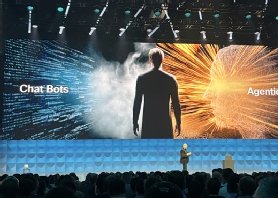Cisco Live 2025: The network critical for the future of the AI era
Network giant unveils simplification of network operations, delivers exponential performance with next-generation devices and fuses security into the network
Cisco has introduced a network architecture attributed with delivering a platform relevant for the new world of work, offering simplicity and speed, and powering the campuses, branches and industrial networks of the future.
Kicking off its Cisco Live 2025 annual showcase, Cisco CEO Chuck Robbins stressed that every business is having to evolve at “an incredible pace”, taking notice of not just technology transitions, but also the global geopolitical landscape, making lives more complicated than they used to be. He added that the new era of authenticity will only be secured by fusing security services into the networks that make business workflows possible.
As it announced the platform, the company quoted findings from its IT networking leader survey, which stressed how a major infrastructure shift was underway and that artificial intelligence (AI) could either double the strain or solve it.
Specifically, the research found that 97% of businesses believe they need to upgrade their networks to make AI and internet of things (IoT) initiatives successful, and the stakes are high: a single severe outage can inflict nearly $160bn in losses globally. Faced with these challenges, IT teams need a new approach to scale operations, reduce downtime, and unlock new levels of efficiency and innovation.
Putting the launch into context at Cisco Live 2025, Cisco president and chief product officer Jeetu Patel (pictured above) warned that as AI transforms work, it will fuel explosive traffic growth across campus, branch and industrial networks, and could overwhelm IT teams with complexity and novel security risks at a time when downtime has never been more costly.
Moreover, he said that going forward, there would only be two types of company: those that are really adept with their use of AI, and those that really struggle. Cisco’s mission, he assured, was to make sure businesses fell into the first category by providing all of the necessary infrastructure safety and security, in addition to supporting AI datacentre build-outs, and to future-proof workplaces through an underlying substrate of global connectivity.
“I think the infrastructure requirements for AI will change quite substantially because of the demand for more compute, more power and more network bandwidth. It’s almost insatiable. Just imagine what the world could do if we weren’t constrained on [these fronts],” said Patel.
“[We will] build out the datacentres, build out the workplaces and make sure that they have secure global connectivity across all of them,” he added. “We will make sure that we are providing our innovations to help organisations move to this era of agentic AI and … we have a bunch of innovations around AI-ready datacentres and future-proofing workplaces.”
Network modernisation
As Patel envisaged the era of agentic AI, he stressed that sometimes enterprises underestimated just how much networking was essential for running an effective AI operation, and that they have to modernise networks to carry the workloads that come with the technology.
“Modern means it’s secure, reliable, high performance,” he said. “You have to re-rack your entire network, or your entire datacentre. You have to rebuild the network, you have to change the latency requirements, you have to change the performance, you have to change power efficiency to be much, much more. And if you do those things right, by definition, your constraints start going down around infrastructure.”

The new architecture is said to deliver the operational simplicity through unified management, next-generation networking devices purpose-built for AI workloads, as well as advanced security capabilities embedded into the network. Indeed, Patel noted that security was now a prerequisite for productivity. The end result was that the new platform could empower enterprises to confidently adopt and scale AI services, giving them a competitive edge.
Cisco regards operational complexity as among the greatest challenges currently facing IT teams, and the unified management platform aims to address this by bringing together the management of Meraki and Catalyst devices, along with support for next-gen wireless, switching, routing and industrial networks. These are delivered from a single platform that supports any cloud, on-premise or hybrid deployment.
The new unified management platform is also said to be further differentiated by ThousandEyes assurance – extended to mobile endpoints, and industrial IoT – to deliver deeper, more actionable visibility into enterprise networks and Microsoft Azure. A new integration between ThousandEyes and Splunk is said to result in SDD real-time insights from network to application, with assurance and observability across both owned and unowned infrastructure, helping ensure consistent performance and operational resilience.
At the heart of the platform is AgenticOps, an AI-driven approach designed to turn real-time telemetry, automation and deep domain expertise into intelligent, end-to-end actions. AgenticOps capabilities are seen as extending across domains and are powered by a new Deep Network Model – a domain-specific LLM. The Deep Network Model also powers the Cisco AI Assistant, a natural-language interface built to identify issues, diagnose root causes and automate workflows.
The claimed result is that AI that understands networks and works the way IT does, reducing task time from hours to minutes. The new AI Canvas offers a generative AI user interface for customer dashboards that enables NetOps, SecOps and DevOps teams to collaborate, optimise operations and reduce IT strain.
Read more about AI for networking
- Extreme Networks ups networking AI ante with Platform One: Cloud networking provider announces limited availability of next-gen networking platform attributed with reducing manual tasks by up to 90%.
- AI and networking: the two sides of the future infrastructures coin: How artificial intelligence is being used to support network management - and the growing requirements on networks to support AI.
- The demands of AI on network as a service: An expert panel at ONUG’s AI Networking Summit Spring 2025 gave insight into the future of AI in networking, particularly in NaaS environments.
- Agentic AI for networking: Catalyst or distraction? Though many networking platforms claim to be agentic, few truly are. Here's how to determine whether a platform is agentic and what this AI wave means for IT.
Cisco Live also saw the company unveil purpose-built hardware intended to meet the unprecedented demands AI workloads will place on networks to deliver the required low latency, high capacity and security for the AI-powered enterprise. Each device is tailored to meet the specific demands of its environment.
The new range is said to represent the largest refresh of networking devices Cisco has carried out, encompassing the needs of campus, branch and industrial IoT applications. The switches are built on Cisco Silicon One core foundation technology featuring custom ASICs that are programmable, so users don’t have to take out a new piece of silicon every single time it has a new use case.
Cisco also announced it was extending its Wi-Fi 7 portfolio with the Cisco Wireless 9179F Series Access Points for stadiums and large venues, and is delivering cloud-managed roaming for large campuses with a Campus Gateway.
To meet the performance and reliability demands of industrial AI use cases, Cisco has introduced ruggedised switches in a variety of form factors to support applications including visual quality inspections and autonomous mobile robots. New critical wireless use cases are now connected with the integration of Ultra-Reliable Wireless Backhaul together with Wi-Fi technology in a single access point.
The new generation of Cisco Smart Switches can deliver up to 51.2Tbps of throughput, below five microsecond latency and quantum-resistant secure networking that the company says will power AI applications. New routers offer native SD-WAN and secure access service edge integration, next-generation firewall, and post-quantum security into a single-box WAN offering – with up to three times the throughput of previous generations.
Commenting on the core of the new switches, Martin Lund, executive vice-president of Cisco’s common hardware group, said what the new devices were based on was a new architecture for a new world, and that businesses had to have capability to be able to adapt to the new workloads.
“The networks have to go faster [with] lower latency, lower power,” he said. “It has to be a more efficient solution and it just keeps going at a rate that’s faster than anything I’ve seen before … The entire stack is being developed and rewritten as we speak. That’s industry-wide. We’re speeding up the innovation.”
Security challenges
Looking at a fundamental aspect of the modern network, Cisco accentuated that enterprise networks face a complex and dynamic security landscape. To combat these continually evolving threats, the company said it was integrating advanced security seamlessly into the network and is unveiling new protections across three critical layers: securing network infrastructure; defending data in transit; and protecting users, endpoints and applications.
For Patel, while clearly stating that security was a prerequisite in the adoption of AI, he stressed how that security was a prerequisite for productivity and that everything started with trust.
“The trust that people have in these systems really matters in the way in which you adopt, you accelerate adoption,” he said. “Without safety and security, you don’t trust the system. If you don’t trust the system, you’re not going to use it.
“And one of the big reasons why we created AI defence was we wanted to have a common substrate of security and safety across every model, every agent, every application, every cloud. And the reason we wanted to be common across is because you want to be consistent, so that if you change out your model, you should not have to rethink your security architecture when you’re building an application.
“Every single time you build an application with the use of AI, you should not be rebuilding your security stack,” said Patel. “In the past, what would happen is you would always make this trade-off between security. If you want to be secure, do you want to be productive? And [now] for the very first time, security is becoming an accelerant to adoption, rather than becoming an impediment.”










